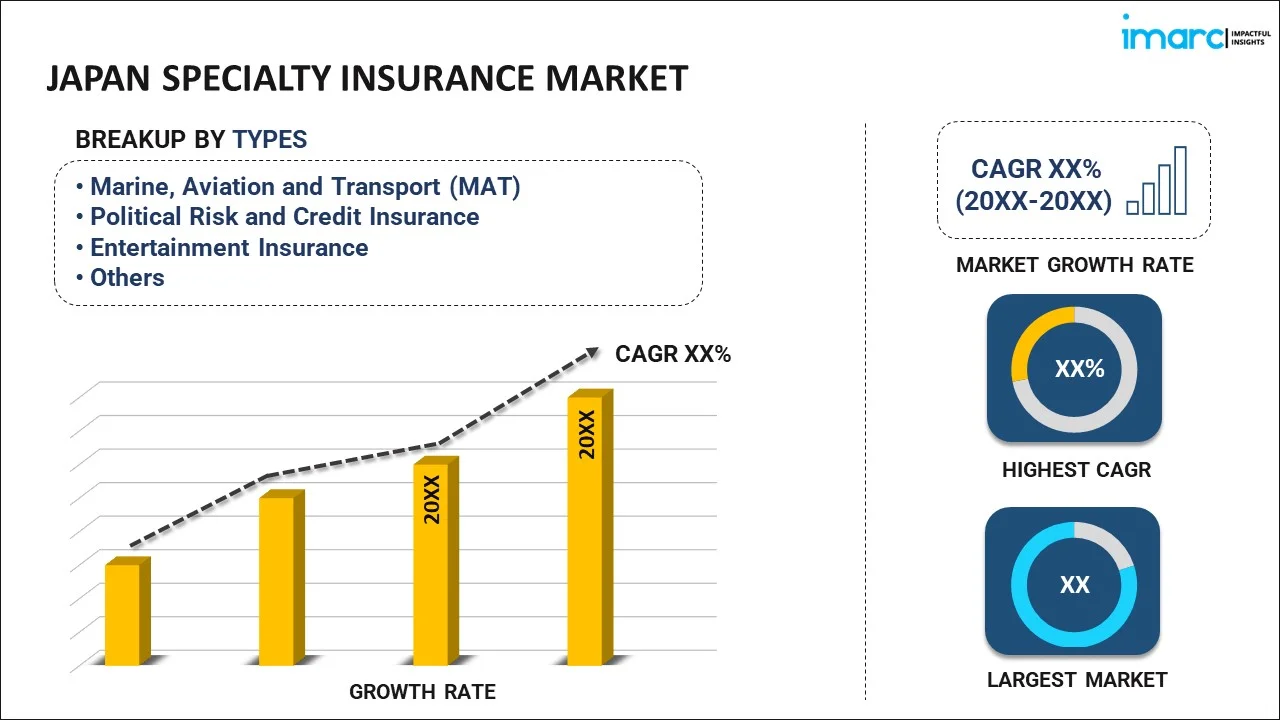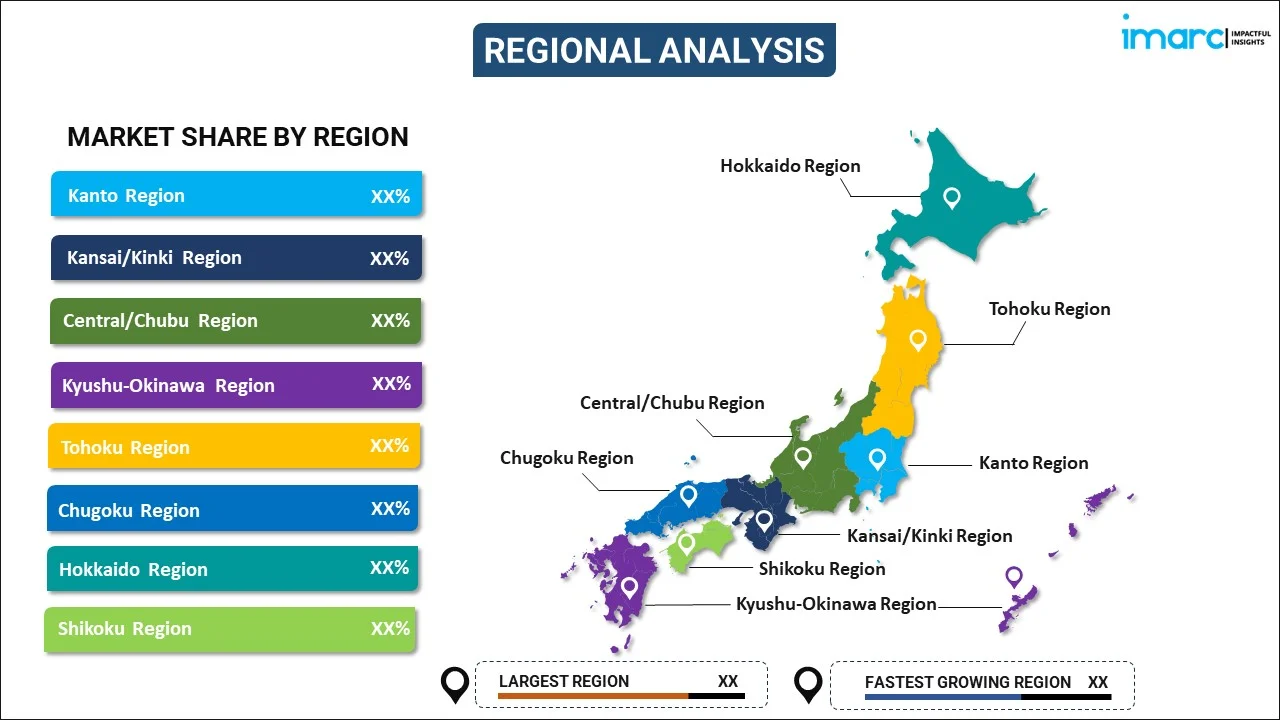
Japan Specialty Insurance Market Report by Type (Marine, Aviation and Transport (MAT), Political Risk and Credit Insurance, Entertainment Insurance, Art Insurance, Livestock and Aquaculture Insurance, and Others), Distribution Channel (Brokers, Non-Brokers), End User (Business, Individuals), and Region 2025-2033
Market Overview:
Japan specialty insurance market size reached USD 5.9 Billion in 2024. Looking forward, IMARC Group expects the market to reach USD 12.7 Billion by 2033, exhibiting a growth rate (CAGR) of 8.8% during 2025-2033. The increasing frequency and sophistication of cyberattacks, which have led to the growth of specialty insurance products like cyber liability insurance that covers the financial and reputational consequences of data breaches and cyber incidents, is driving the market.
|
Report Attribute
|
Key Statistics
|
|---|---|
|
Base Year
|
2024 |
|
Forecast Years
|
2025-2033
|
|
Historical Years
|
2019-2024
|
| Market Size in 2024 | USD 5.9 Billion |
| Market Forecast in 2033 | USD 12.7 Billion |
| Market Growth Rate (2025-2033) | 8.8% |
Specialty insurance is a type of coverage that is designed to provide protection for unique or specialized risks that are not typically covered by standard insurance policies. These policies are tailored to meet the specific needs of individuals, businesses, or organizations operating in niche industries or facing uncommon risks. Specialty insurance can encompass a wide range of sectors, including aviation, marine, cyber, environmental, and more. It offers coverage for situations such as professional liability, fine art, event cancellation, and even kidnap and ransom scenarios. Because these risks often require specialized knowledge and underwriting expertise, specialty insurers are usually well-versed in the intricacies of their respective markets. By offering coverage for specialized risks, specialty insurance helps individuals and businesses manage their unique exposures and avoid financial losses that may be catastrophic without adequate protection. It plays a crucial role in the broader insurance industry by filling gaps left by standard policies, ensuring that even the most specialized and unusual risks can be mitigated through appropriate coverage.
Japan Specialty Insurance Market Trends:
The specialty insurance market in Japan is driven by a myriad of factors, each contributing to its growth and dynamism. Firstly, the ever-evolving risk landscape, characterized by emerging technologies and changing business models, plays a pivotal role. As industries embrace new technologies like artificial intelligence and blockchain, they face unique risks that demand specialized insurance coverage. Furthermore, regulatory changes and increased scrutiny necessitate tailored insurance solutions to ensure compliance and mitigate potential liabilities. Apart from this, societal shifts, such as the increasing importance of sustainability and environmental concerns, drive demand for specialty insurance that addresses environmental risks and sustainable business practices. Furthermore, the rising importance of business interruption coverage spurs interest in specialty policies that specifically address these unexpected disruptions. Lastly, the emerging need for cybersecurity insurance, fueled by the escalating threat of cyberattacks, is creating a positive outlook for the market. In sum, the specialty insurance market in Japan thrives on the convergence of these diverse factors, making it a dynamic and ever-evolving industry.
Japan Specialty Insurance Market Segmentation:
IMARC Group provides an analysis of the key trends in each segment of the market, along with forecasts at the country level for 2025-2033. Our report has categorized the market based on type, distribution channel, and end user.
Type Insights:

- Marine, Aviation and Transport (MAT)
- Marine Insurance
- Aviation Insurance
- Political Risk and Credit Insurance
- Entertainment Insurance
- Art Insurance
- Livestock and Aquaculture Insurance
- Others
The report has provided a detailed breakup and analysis of the market based on the type. This includes marine, aviation and transport (MAT) (marine insurance and aviation insurance), political risk and credit insurance, entertainment insurance, art insurance, livestock and aquaculture insurance, and others.
Distribution Channel Insights:
- Brokers
- Non-Brokers
A detailed breakup and analysis of the market based on the distribution channel have also been provided in the report. This includes brokers and non-brokers.
End User Insights:
- Business
- Individuals
The report has provided a detailed breakup and analysis of the market based on the end user. This includes business and individuals.
Regional Insights:

- Kanto Region
- Kansai/Kinki Region
- Central/ Chubu Region
- Kyushu-Okinawa Region
- Tohoku Region
- Chugoku Region
- Hokkaido Region
- Shikoku Region
The report has also provided a comprehensive analysis of all the major regional markets, which include Kanto Region, Kansai/Kinki Region, Central/ Chubu Region, Kyushu-Okinawa Region, Tohoku Region, Chugoku Region, Hokkaido Region, and Shikoku Region.
Competitive Landscape:
The market research report has also provided a comprehensive analysis of the competitive landscape. Competitive analysis such as market structure, key player positioning, top winning strategies, competitive dashboard, and company evaluation quadrant has been covered in the report. Also, detailed profiles of all major companies have been provided.
Japan Specialty Insurance Market Report Coverage:
| Report Features | Details |
|---|---|
| Base Year of the Analysis | 2024 |
| Historical Period | 2019-2024 |
| Forecast Period | 2025-2033 |
| Units | Billion USD |
| Scope of the Report | Exploration of Historical Trends and Market Outlook, Industry Catalysts and Challenges, Segment-Wise Historical and Future Market Assessment:
|
| Types Covered |
|
| Distribution Channels Covered | Brokers, Non-Brokers |
| End Users Covered | Business, Individuals |
| Regions Covered | Kanto Region, Kansai/Kinki Region, Central/ Chubu Region, Kyushu-Okinawa Region, Tohoku Region, Chugoku Region, Hokkaido Region, Shikoku Region |
| Customization Scope | 10% Free Customization |
| Post-Sale Analyst Support | 10-12 Weeks |
| Delivery Format | PDF and Excel through Email (We can also provide the editable version of the report in PPT/Word format on special request) |
Key Questions Answered in This Report:
- How has the Japan specialty insurance market performed so far and how will it perform in the coming years?
- What has been the impact of COVID-19 on the Japan specialty insurance market?
- What is the breakup of the Japan specialty insurance market on the basis of type?
- What is the breakup of the Japan specialty insurance market on the basis of distribution channel?
- What is the breakup of the Japan specialty insurance market on the basis of end user?
- What are the various stages in the value chain of the Japan specialty insurance market?
- What are the key driving factors and challenges in the Japan specialty insurance?
- What is the structure of the Japan specialty insurance market and who are the key players?
- What is the degree of competition in the Japan specialty insurance market?
Key Benefits for Stakeholders:
- IMARC’s industry report offers a comprehensive quantitative analysis of various market segments, historical and current market trends, market forecasts, and dynamics of the Japan specialty insurance market from 2019-2033.
- The research report provides the latest information on the market drivers, challenges, and opportunities in the Japan specialty insurance market.
- Porter's five forces analysis assist stakeholders in assessing the impact of new entrants, competitive rivalry, supplier power, buyer power, and the threat of substitution. It helps stakeholders to analyze the level of competition within the Japan specialty insurance industry and its attractiveness.
- Competitive landscape allows stakeholders to understand their competitive environment and provides an insight into the current positions of key players in the market.
Need more help?
- Speak to our experienced analysts for insights on the current market scenarios.
- Include additional segments and countries to customize the report as per your requirement.
- Gain an unparalleled competitive advantage in your domain by understanding how to utilize the report and positively impacting your operations and revenue.
- For further assistance, please connect with our analysts.
 Inquire Before Buying
Inquire Before Buying
 Speak to an Analyst
Speak to an Analyst
 Request Brochure
Request Brochure
 Request Customization
Request Customization




.webp)




.webp)












